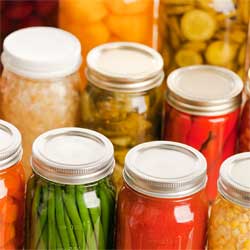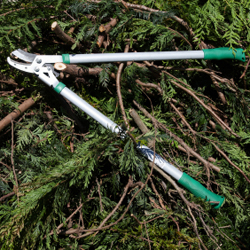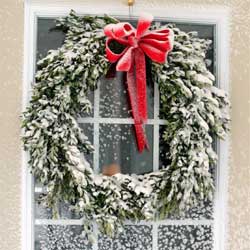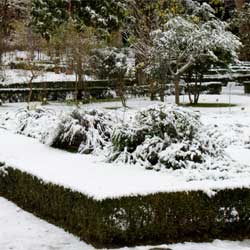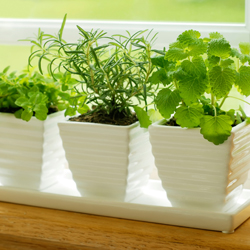Winter is upon us. Depending upon the temperatures, there may still be time to finish remaining chores. If you have any questions about the following procedures or products, please come in and see us. We can help you select the correct dormant oil, fertilizer, selective herbicide and frost protection method. We’re always here to help.
General Landscape
- Mulch garden beds in preparation for winter. Mulching helps conserve moisture as well as maintain more even soil temperatures. In areas where the ground experiences frequent freezing and thawing, this is particularly important.
- Protect broadleaf evergreens from winter’s drying sun and wind. Spray with an anti-desiccant.
- As shrubs and perennials go dormant, clean your garden beds, removing any spent flower heads and dying foliage or branches. Remove summer blooming annuals and vegetables as frost kills them. Leave dried foliage of ornamental grasses for an interesting winter effect. Fall cleanup eliminates places for insects and diseases to over-winter.
Houseplants
- Remember that gardening is not just confined to outside. Start an herb garden on a sunny windowsill. Bring color and texture to your living room, kitchen, bedroom, and bathroom – anywhere – with blooming and foliage houseplants.
- Perk up tired houseplants by removing dead and dying leaves. Wash under a soft shower in the sink or tub.
- Spider mites proliferate in warm dry winter homes. Check for mites by looking for tiny speckles on leaves.
- Transplant if roots are growing through the drainage holes or over the pot edge. If you don’t want to move into a larger pot, untangle the roots and cut back by 1/3, scour the pots and replant with new soil.
- Remember to turn your plants each week as they begin to grow towards the weaker window light.
- For indoor bloom, plant amaryllis, paper white narcissus, hyacinth, crocus and indoor cyclamen.
- Be creative in your arrangements and combine them with metallic painted twigs, pinecones or seashells.
Lawn:
- Remove leaves, garden furniture, toys, hoses, etc., from lawns to prevent dead spots.
- Apply winter fertilizer, if not already done.
Vegetables:
- Protect cool season vegetables with row covers, leaf or mulch cover.
- Mulch beds to enrich and protect from rain/snow erosion.
- Plant cover crops.
- Review gardening notes and plan next year’s garden.
- Test germination rate of leftover seeds, if wanting to use again.
- Harvest carrots, lettuce, greens and over-wintering crops.
- Remember, spring is just around the corner! Plan next Spring’s flower and vegetable gardens…our seeds will be arriving soon!
Trees and Shrubs
- Trees, shrubs, perennials, groundcover and bulbs can still be planted as long as the ground is not frozen.
- Stake young trees and vines if needed. In case of a heavy freeze, use Wilt Pruf or similar product to reduce transpiration of moisture.
- Fertilize shrubs and trees, if not done already, and the ground is not frozen. This allows roots to absorb when temperatures are above 40° and when spring returns. Granules and spikes provide nutrients effectively and easily.
- Plant a live Christmas tree as part of a windbreak.
- Prune out dead and diseased tree branches to prevent from falling on roof or pedestrians.
- If using a live tree for a “living Christmas tree”, prolong its time indoors by using Wilt Pruf to reduce the loss of moisture from the needles.
